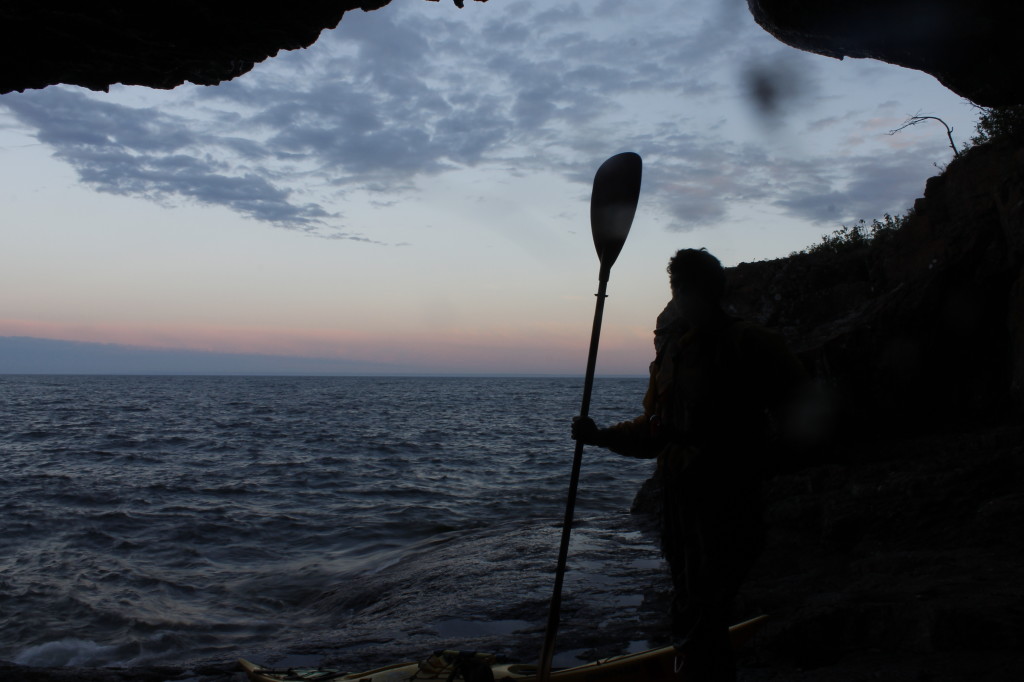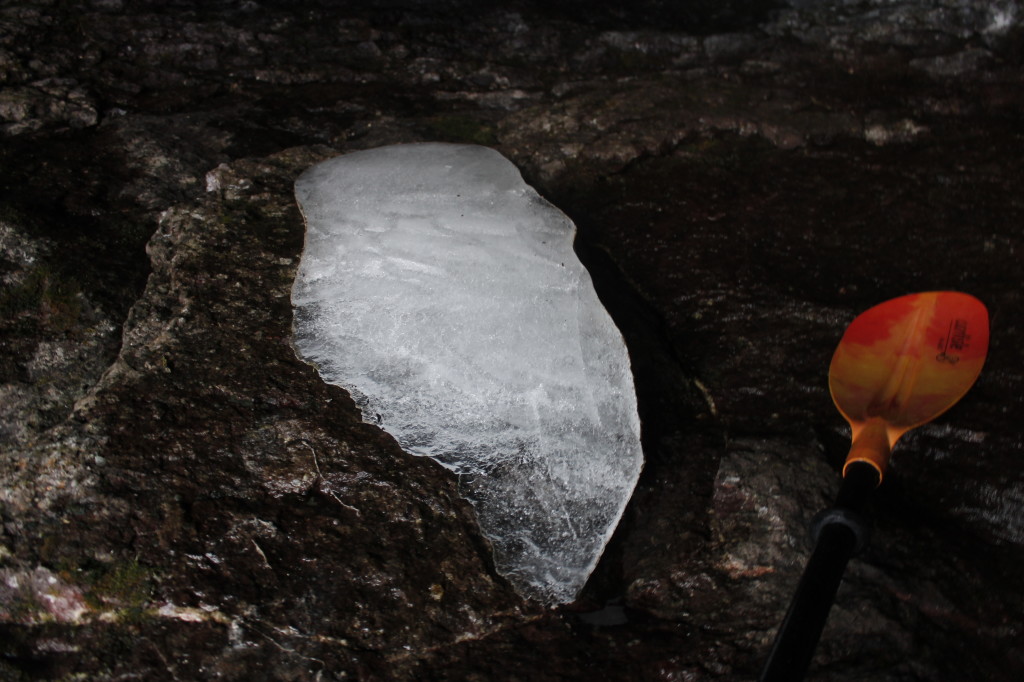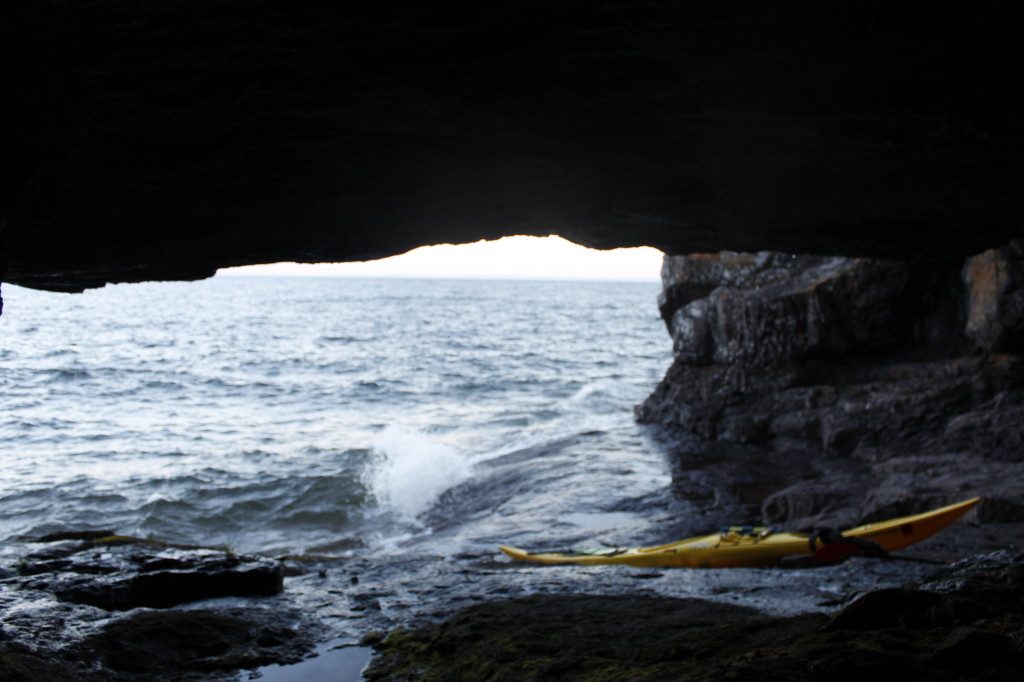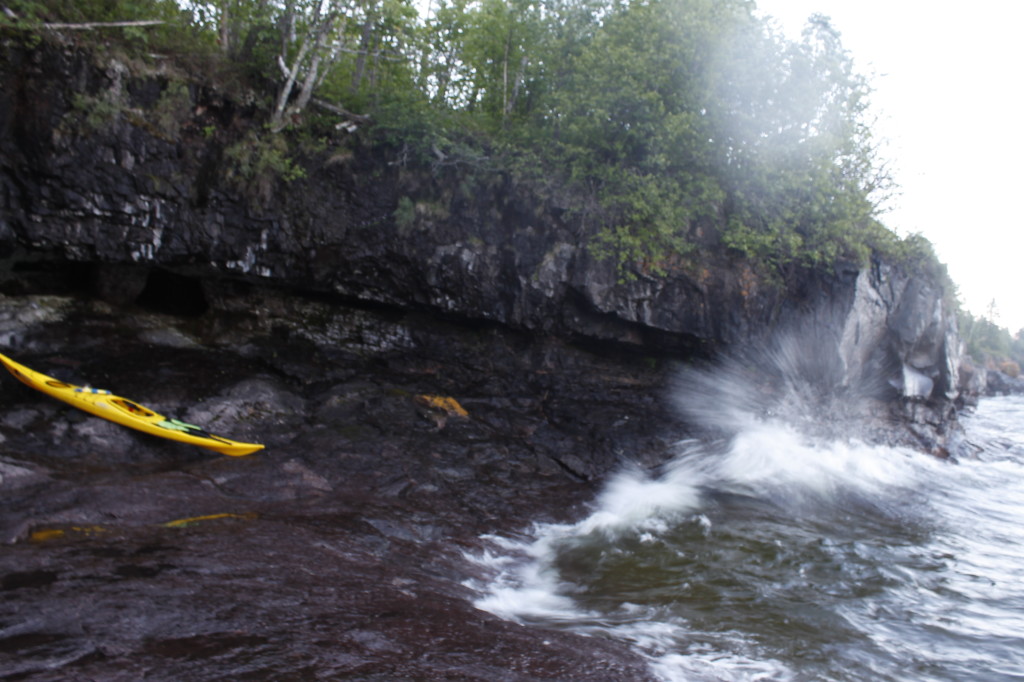
The kayak bobbed up and down on rolling three-foot swells as I paddled along the basalt cliffs of Lake Superior.
It was almost 9 p.m. but at the end of June on the North Shore, that still left me at least a good hour of decent light before the darkness. The ostentatious lake homes to my right gave way to depopulated state forest, where raggedy birch and aspen flashed the underside of their leaves in the offshore wind.
Then I found my cool place. It’s a break in the cliffs where the millennia of pounding surf have blasted out an alcove. There’s a rock shelf, leading up to a living room-sized space, where a visitor can stand underneath an overhang, protected from any rainfall, wrapped up in the shadow of the stone.
I paddled closer.
Waves flew in at the rock and exploded up like fireworks. Water piled up on the shelf and then flowed backwards, creating a small outward current above the waves’ up-down motion.
Even bobbing in the surf, I could still make out the telltale patch of white in the alcove’s gloom. There was ice here.
Ice! And it was almost Independence Day.
The frigid legacy of the 2013-14 winter still lingered where the ledges protected it from the sun. Maybe 20 pounds of the stuff was left now, and it was vanishing drip by drip into the lake, which had pushed it up here.
Only a few months before, Superior had been completely frozen, all 32,000 thousand square miles of it. It was the first time this had happened since 1979.
I had to get out for a closer look.
I approached the rocks with the caution of someone coming up on a dangerous animal. I would need to get up on shore right behind a wave and get out quickly before the next one crashed over me.
I popped my spray skirt off at 10 feet away; then got my feet out of the cock pit, while my butt was still in the seat, ready to swing out of the boat with acrobatic ease. Of course, nothing works as prettily as it’s supposed to.
I landed in waist deep water on an algae-slick stone slope. I almost fell over right there, but managed to steady myself against the boat — just in time for the next wave to slam it against my hips. Using a set of ballerina steps, I managed to mince my way up the rock while keeping the boat perpendicular to the waves. I finally heaved it onto the rock in front of me and dragged myself up after it.
The waves were still grabbing up the boat several feet up the ledge, so I ended up pulling it even further, before I decided it was safe to let go.
The alcove is hardly the grandest place around, not even on Lake Superior, which boasts massive sea-caves around the Apostle Islands and Tettegouche State Park. Still I was pleased to walk past the curtain of drips from above into the darker recesses. There, I could look back over the miles of water to the horizon line. The silhouetted rock framed this beautifully.
The waves had wrought a pillar out of one section of the wall, which was a nice architectural flourish. Then there was the ice. It was mostly white, though there were some transparent parts along the edges. I photographed it next to a kayak paddle to remember it. Soon it would be gone, and this made me sad.

I was proud too. No one I’d talked to about the lakeshore had mentioned this little alcove. I’m sure I was the only one who knew that there was still ice here. The place was easy enough to overlook from a motorboat skipping along the waves at high speed.
As for accessing it from land, it would be difficult, dangerous work to try to descend the walls.
I found it. Maybe this could be my place.
No, I hadn’t carved the rock, or kept the ice sequestered there, but I still felt a strange sense of ownership. The feeling is familiar to anyone who “discovers” a dive bar, a band or maybe a continent and feels like he deserves some credit for appreciating it before his friends do.
Of course, I needed to bring said friends along so that they could appreciate it too. The problem is that then, the place is no longer undiscovered, it is no longer has the quality of being unique and unknown. Imagine John Wesley Powell revisiting the Grand Canyon to find tour buses and T-shirt vendors lining the south rim.
I wish I could say I was strong enough to be an exception to this trend. I’ve been guiding customers on kayak trips along the shoreline. Could I really keep this under my hat? Already, I thought about how cool it would be to show the people in my group the last ice on Lake Superior.
Sure enough, as soon as I got back to my apartment, one of my housemates asked what I’d been up to and I told him about the ice I’d found. I couldn’t resist showing photos of the alcove to the other guides, who — unlike me — had not discovered it yet.
I wondered if I’d keep my mouth shut for the next guided tour. When I found that I was with a stronger group and we still had plenty of time left at the turn-around point, I asked if anyone was interested in going to an interesting formation a bit further down the shoreline.
I pointed to the remaining ice in the alcove and got murmurs of appreciation mixed with wonder from the visitors. It was July 1 now and the ice wasn’t going to last much longer.
Satisfying as it was to see others enjoy the ice, I knew that it was just another part of the package for them. Rambling across it myself made me feel like I’d owned a part of it, though now the guests had a claim on it as well.
Well, sharing can be a virtue also, I suppose.
In any case, not many more got to say they saw the ice. The last of it melted off during the first hot days that rolled in ahead of the Fourth of July.


